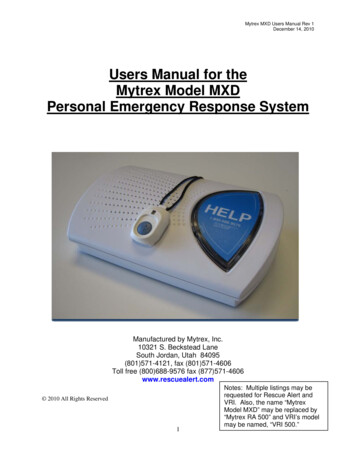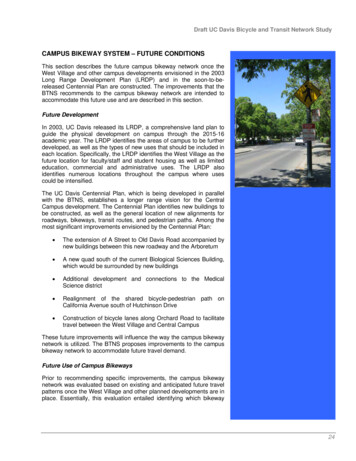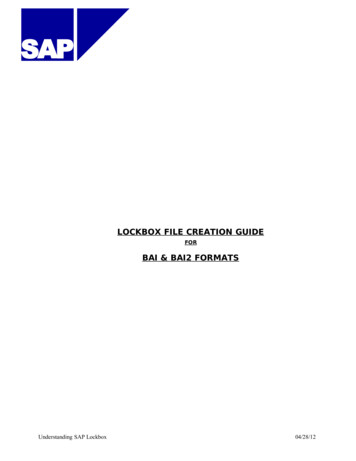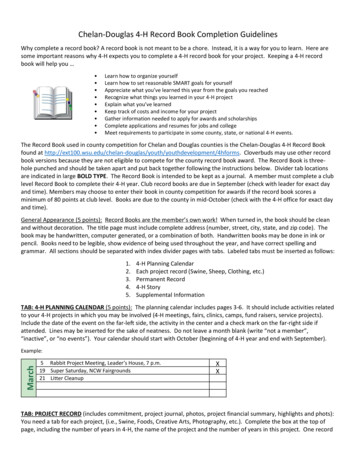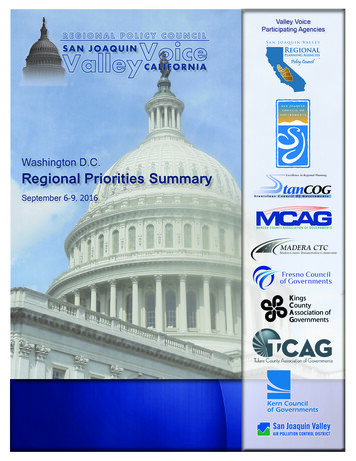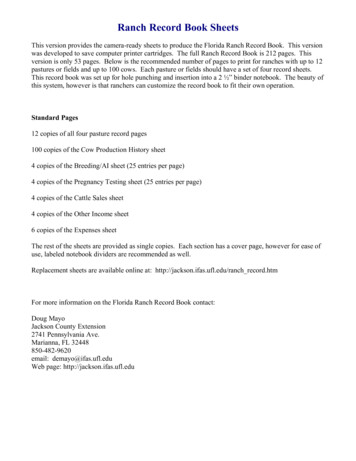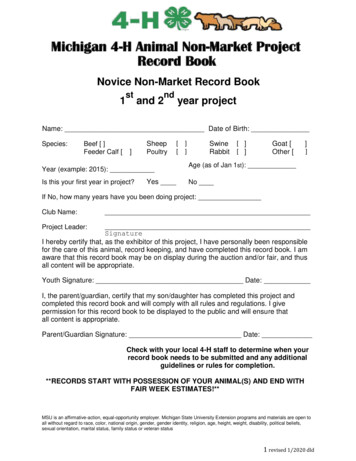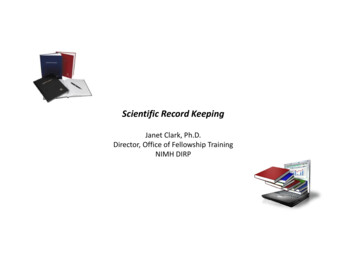
Transcription
MxD PROJECT RECORDTERMINATION REPORTDMDII-14-03-01:Digital Manufacturing CommonsRevision 1.0 Date: July 30, 2020Contact:Daniel ReedSenior Project EngineerMxDprojects@mxdusa.orgMxD1415 North Cherry AveChicago, IL 60642SPONSORSHIP DISCLAIMER STATEMENT: This project was completed under the Cooperative AgreementW31P4Q-14-2-0001, between U.S. Army - Army Contracting Command - Redstone and UI LABS on behalf of theDigital Manufacturing and Design Innovation Institute. Any opinions, findings, and conclusions or recommendationsexpressed in this material are those of the author(s) and do not necessarily reflect the views of the Department ofthe Army.DISTRIBUTION STATEMENT A. Approved for public release; distribution unlimited.Volume 1 - Technical Proposal - Page 1
TABLE OF CONTENTSI.Record of Change. 3II.Executive Summary . 3III.Introduction and Background . 3IV.Project Outcome Summary . 4V.Technical Summary of Intended Scope . 5Technical Requirements . 5VI.Project Final Outcome . 11Lessons Learned . 11Milestones Achieved . 13Deliverables Received . 14Volume 1 - Technical Proposal - Page 2
I.RECORD OF CHANGERevision1.0II.Date30 July, 2020SectionsN/ADescriptionOriginalEXECUTIVE SUMMARYThe Digital Manufacturing Commons (DMC) was envisioned to be an open-source platform tofoster real-time collaboration among various stakeholders across the engineering lifecycle. Theplatform would democratize the development and use of design-build tools by hosting a cloudbased marketplace for digital thread applications. The DMC would leverage foundational CAD andanalysis tools but also encourage an ecosystem of user-based applications through openapplication programming interfaces (APIs) and services. These key innovations would enable bothprofessionals and community contributors to design components, together or independently, andthen utilize the myriad of DMC-based tools to analyze, test and harden those designs beforerelease.This platform would be overlaid with identity controls to allow users to secure or share theirprojects, models and data openly or in a secure manner. This would allow a broad range of usecases from open-source, community-driven projects to efforts driven entirely within internalorganizations. The DMC would enable the US industrial and innovation ecosystem by connectingthe right people with the right data and the right tools for advanced design and analysis.Technical development commenced for two years, but the program was impacted by both technicaland programmatic obstacles. These obstacles were managed effectively until the project was nolonger feasible, cost-effective, or advancing along set milestones. At that point, the program wascancelled because it no longer aligned with the needs of the membership base. The teamrecouped project work and the investment was ported into what became and currently serves asthe institute’s Membership Portal, housing member-only project and technical information.III.INTRODUCTION AND BACKGROUNDMxD (then DMDII) is the nation’s flagship research institute for applying cutting-edge digitaltechnologies to reduce the time and cost of manufacturing and strengthen the capabilities of theU.S. supply chain, and reduce acquisition costs for the DoD. DMDII worked to develop anddemonstrate digital manufacturing technologies and then deploy and commercialize thesetechnologies across key manufacturing industries.The goal of this project, “Digital Manufacturing Commons,” was to establish and implement thecore elements of the Digital Manufacturing Commons (DMC) as an open-source platform forsecure and trusted real-time collaboration during the design-make process and to develop an initialset of foundational applications that utilized the DMC platform which were seen critical to thefunction of the Institute.The DMC was architected as an open-source platform with the goal to revolutionize the wayproducts are designed, made, and distributed by facilitating collaboration, data analysis, andintegration across all parts of the product life cycle. It was envisioned that the DMC would bringtogether approximately 1 million users—thousands of SMEs, manufacturing companies, anduniversities—to collaborate on manufacturing and to accelerate technologies that integrate thedigital thread.Volume 1 - Technical Proposal - Page 3
Figure 1. Illustration of what Digital Manufacturing is and what part of the process the DMCcovers. Design innovation is the ability to apply these technologies, tools and products to reimagine the entire manufacturing process from end-to-end.The DMC would enable a fundamentally new way for digital information to be collected and usedacross the entire product life cycle, to and from intelligent machines and workers on the shop floor,and through supply chains. The DMC was to be a mechanism for project collaboration amongInstitute members. The DMC would provide a low barrier-to-entry collaboration platform where thebroader digital manufacturing and design innovation community can contribute content. The DMCplatform would allow distributed teams to collaborate within a common virtual workspace, allowingdesigners and makers to work together on projects by sharing data and files. The DMC wouldallow connections to software and analysis tools, cloud computing and high-performancecomputing. The structure of the DMC would allow for the addition of functionality in the form ofapplications from a broad community.IV.PROJECT OUTCOME SUMMARYDevelopment on the Digital Manufacturing Commons was halted on April 15, 2017. Until that point,the team had built a platform with identity controls, active workspaces where organizations couldrun multiple physics-based apps, a marketplace that hosted available applications, an institutemember portal, and an interface point for digital manufacturing workforce development content.DMDII along with its members and Executive Committee explored many potential applications ofthe DMC platform and evaluated its corresponding software development business model. Thatanalysis showed that DMC’s DOME-based architecture involves significantly higher developmentand maintenance costs as compared to more modern micro web services and container-basedapproaches. The consensus feedback across DMDII partners was that the DMC as originallyconceived will not drive a significant ROI for their organizations and will be too costly tosuccessfully scale. As a result, DMDII shelved its work on the DOME-based platform and hasactively pursued new lightweight, commonly used architectural models that can more costeffectively support specific cloud-based applications on an as-needed basis.After it was determined that the DMC did not meet the current needs of the membership, UI Labsleadership decided to focus on the member portal component of the DMC. This decision was madedue to mounting technical risk and lack of engagement by the broader consortium, which was anVolume 1 - Technical Proposal - Page 4
indicator that there was not clear value to the target customer base. A portion of this disinterestcould be related to the fact that the DMC posed a competitive platform to the larger solutionproviders in the institute’s ecosystem, but also to the fact that the simulation marketplace conceptwas still ahead of its time. The technology is feasible as demonstrated by the DMC, but the marketis still immature.Most of the manufacturing sector still incorporates traditional business processes that are rigid andsiloed. Thus, the adoption of such a platform would be reliant on more than traditional marketing,engagement and training, it would also have to be focused on selling the benefits of distributedmanufacturing and a new way to do business. Due to its marketplace/commons concept, theDMC’s value proposition required engagement to create a community of value. While thetechnology to create a physics-driven simulation marketplace was feasible, the amount ofinvestment in time and technical resources to populate the platform with user-submitted contentwas not a compelling value proposition to the UI Labs membership at the time. Overall, the keytakeaway is that the platform contained technological interest and potential, but did not havesufficient product/market fit and was not something the membership was willing to invest further in.Having made this determination, the team pivoted towards refining the piece of the DMC that hadclear value for the consortium moving forward.The Member Portal was a platform that incorporated many of the community-driven features of theDMC such as identity authorization and access controls but had a much more directed focus. TheMember Portal was built as MxD’s engagement platform, to allow all members of the consortium tointeract and get access to the latest information on events, workshops, and most importantly,enterprise projects. At its core, the portal would host all the technology outcomes for the institute’sresearch portfolio and members would be able to access these outcomes in accordance to theirtier level as defined by the institute’s Membership Agreement. The Member Portal is the mainaccess point to MxD’s R&D deliverables and is still in use today.V.TECHNICAL SUMMARY OF INTENDED SCOPETECHNICAL REQUIREMENTSTask 1 – Software DevelopmentRationaleThe team will use an Agile approach to build the DMC operating environment to include thecore infrastructure, test environments, user interface (UI) and user experience (UX), featureplanning and development, as well as feature extensions and releases over the period ofperformance. The DMC will integrate with an existing identity provider to provide various levelsof access and different types of user authentication. The system will also undergo third-partysecurity assessment and functionality testing. The system will include demonstration modelsbased on a broad community application and one with a military focus and will allow for customexecutable models.ApproachAn Agile development process is envisioned for the DMC. Agile development processesemphasize early feedback and accommodating evolving requirements. An Agile approach willproactively accommodate these changes quickly.Task 1.1—Establish Core Infrastructure (Q1, 2015)Volume 1 - Technical Proposal - Page 5
Task 1.2—Establish Performance Testing Environment (Q1, 2015)Task 1.3—Develop UI/UX (Q2, 2015)Task 1.4—Plan Features (Q3, 2015)Task 1.5—Develop Capability, Feature Extensions and Releases (Q1, 2015 – Q3, 2016)Task 1.6—Integrate Large Scale Identity Provider (Q2, 2015)Task 1.7—Asses System Security, Enhancement and Patching (Q3, 2015)Task 1.8—Customize Site (Q1, 2015 – Q3, 2016)Task 1.9—Integrate Information Technology Infrastructure (Q1, 2015 – Q3, 2016)Task 1.10—Complete Software Quality Assurance (Q1, 2015 – Q3, 2016)Milestones Prioritized software development backlog – Q1, 2015Initial release of DMC branded website – Q2, 2015DMC platform release with recommended security risks mitigated and validated – Q3, 2015Software quality environment established and populated with initial testing procedures – Q1,2015Software release incorporating newly developed user experience and functionality – allquartersTask 2 – Administrative ServicesRationaleAdministrative services will be developed to manage the underlying processes to keep theDMC secure and functioning as expected. These include processes for enrollment ofindividuals and groups, security, and risk mitigation, Governance procedures and user andwebsite support.ApproachAn Agile development process is envisioned for the DMC. Agile development processesemphasize early feedback and accommodating evolving requirements. An Agile approach willproactively accommodate these evolving changes quickly. Task 2.1—Develop, manage and maintain process to enroll individuals into the identityservice(Q1, 2015 – Q3, 2016)Task 2.2—Develop, manage and maintain process to enroll groups into the identity service(Q1, 2015 – Q3, 2016)Task 2.3—Establish, manage and implement security and risk mitigation procedures(Q1, 2015 – Q3, 2016)Task 2.4—Establish and manage governance procedures (Q1, 2015 – Q3,2016) Task 2.5—Establish and manage UI and website (Q1, 2015 – Q3,2016)Milestones Initial DMC user Identity established – Q2, 2015Volume 1 - Technical Proposal - Page 6
User support documentation released – Q4, 2015Task 3—Community OnboardingRationaleThe team will develop a methodology to train individuals to use the DMC to ensure the longevity ofthe DMC.ApproachAn Agile development process is envisioned for the DMC. Agile development processesemphasize early feedback and accommodating evolving requirements. An Agile approach willproactively accommodate these evolving changes quickly.Task 3.1—Develop and test digital lab onboarding framework (Q1, 2015 – Q3 2015)Task 3.2—Develop training, documentation and DMC system engineering workshop(Q1, 2015 – Q3 2015)Milestones Initial DMDII funded project on-boarded to DMC – Q3 2015Hosted semi-annual DMC workshop – Q3, 2015 and Q1, 2016Initial DMC use cases deployed and publicized – Q2, 2015Task 4 –Community ManagementRationaleThe team will develop strategies for sale and marketing the DMC. This includes developing aknowledge center to inform users of things such as, “how to and FAQs”.ApproachAn Agile development process is envisioned for the DMC. Agile development processesemphasize early feedback and accommodating evolving requirements. An Agile approach willproactively accommodate these evolving changes quickly.Task 4.1—Develop and implement a marketing and sales strategy (Q1,2015 – Q3, 2016)Task 4.2—Develop and Implement a User’s Knowledge Center (Q1, 2015 – Q3, 2016)Task 4.3—Develop a process to Manage DMC content (Q1, 2015 – Q3, 2016)Milestones Knowledge center released as part of DMC platform – Q1, 2016Task 5—Program ManagementRationaleThe Principal Investigator will monitor the development process to ensure all deliverables arebeing met on-time and on-budget. The Principal Investigator will also be responsible for recruitingtalent to fill key positions required at the DMCVolume 1 - Technical Proposal - Page 7
ApproachAn Agile development process is envisioned for the DMC. Agile development processesemphasize early feedback and accommodating evolving requirements. An Agile approach willproactively accommodate these evolving changes quickly.Task 5.1—Kick-off (Q1 ’15)Task 5.2—weekly items of interest (Q1, 2015 – Q4, 2016)Task 5.3—monthly meetings and updates (Q1, 2015 – Q4, 2016)Task 5.4—Quarterly reports (Q1, 2015 – Q4, 2016)Task 5.5—Recruitment and hiring (Q1, 2015 – Q4, 2016)Task 5.6—Transition DMC to long term operations team (Q1, 2015 – Q4, 2016)Milestones DMC operations transferred to UI Labs – Q3, 2016Figure 2. Summary of the proposed project.Volume 1 - Technical Proposal - Page 8
mxdusa.org@mxdinnovatesinfo@uilabs.org1415 N. Cherry AvenueChicago, IL 60642(312) 281-6900Figure 3. Schedule, tasks, and milestones of the proposed program.Project Termination Report August 13, 20209
mxdusa.org@mxdinnovatesinfo@uilabs.org1415 N. Cherry AvenueChicago, IL 60642(312) 281-6900Figure 4. Program deliverables.Project Termination Report August 13, 202010
mxdusa.org@mxdinnovatesinfo@mxdusa.orgVI.1415 N. Cherry AvenueChicago, IL 60642(312) 281-6900PROJECT FINAL OUTCOMELESSONS LEARNEDThe DMC was built off a code base that was advanced at GE after being received by MIT. Thiscore technology—the Distributed Object-based Modeling Environment (DOME)—possessedsome of the functionality required by the DMC as a baseline, however it also represented alarge volume of legacy code. This presented significant challenges as a greater-than-expectedamount of work was needed to design interfaces around DOME to support new features. Due toextensive costs and the unforeseen risks that would not materialize until later in the project’sfuture, the program did not decide to modernize the core intellectual property with newtechnology. In hindsight, this would have been the more efficient path as a considerable amountof work was put into developing compatible interfaces over building new value.In addition to the challenges posed by the legacy code base, there was additional challengesthat arose that put additional technical pressure on the team. On July 1, 2015, the DigitalManufacturing and Design Innovation Institute (now MxD) released the “15-16: Open-SourceSoftware Applications for Digital Manufacturing” project call that was focused on fundingproposals for populating the DMC with open data and applications to demonstrate how openapplications can solve real world problems for manufacturers. This project call was the next stepin the platform’s product roadmap but added additional challenges for the team. The internalteam was now in the core of platform development but also balancing the unique projectintegrations as well. Each of these integrations required hands-on time with the projectparticipants to understand unique project-specific requirements, design and develop theappropriate interfaces and employ effective technology management across the project.Programmatic Lessons LearnedAs with all endeavors, the technical soundness of a venture does not always correlate to itssuccess. In the case of the DMC, there were many programmatic issues that presentedobstacles to the UI Labs technical team in completing their objectives for the platform andultimately led to the cancellation of the project. The programmatic hurdles are described in detailbelow.The delay in project contracting was a major issue impeding the successful execution of the 1403-01 project. The project call was released on July 1, 2014, but due to difficulties in pre-awardnegotiations, the final award was not administered until October 1, 2015. Unfortunately, thedelays to the project start did not only shift the expected project kickoff date, it disrupted theavailability of the planned resources that were going to participate on the project from GE GlobalResearch. GE had a team of qualified engineers and developers that were proposed to supportthe effort, but due to the timing of the award and internal issues at GE, the organization couldnot retain a sufficient workforce to staff the development of the Digital Manufacturing Commons.Per the initial contract, GE was contracted to complete the development and provide thetechnology to UI Labs to operate and maintain. Due to the difficulties they faced with inadequatestaffing and lack of organizational resources, what they provided was reduced to the DOMElegacy code base and some design resources, which was a fraction of what they were obligatedto provide in the contract. Due to the nature of the consortium and GE’s current situation,accountability was shifted away from the GE team and absorbed by UI Labs. The UI Labs teamRequest for Proposal August 13, 202011
mxdusa.org@mxdinnovatesinfo@uilabs.org1415 N. Cherry AvenueChicago, IL 60642(312) 281-6900was then mobilized to recruit a team of technical resources outside of their original staffing planand complete the development internally.One of the biggest lessons learned was related to product management. The vision for the DMCwas transformative, but the broad multi-functional design of the platform also increasedcomplexity and reduced focus. This was a common theme for the DMC team as the potential forthe platform was extraordinary, but the scope was too large to properly demonstrate thebusiness value in the period of performance.Additionally, this problem was exacerbated because of a consistent change in productleadership and technical staff. There were seven changes in executive leadership, which led toresources being dedicated to knowledge transfer and getting new executives up to speed. Withthe change in leadership, there was also a change in product vision, which led to inefficienciesin the development as the focus was always in flux. This was further complicated by theconstraints of the contract, as each change in focus led to a shift in work, which had to berenegotiated into the contract before the team would execute.Research and development is central to the competitiveness of the United States, but it isimportant to remember that it is not a surefire path to success. There is an inherent amount ofrisk and uncertainty that obscure the potential return on investment of R&D pursuits on thecutting edge. According to the Defense Innovation Unit, only 23% of the organization’scompleted projects transitioned to the field. This may be a staggering rate of failure for othercore activities, but it is the reality for research and innovation. The DMC was a platform that hadtransformative potential, but the technology, market and staffing related risks provedinsurmountable barriers towards its success. Lessons learned and the followingrecommendations will be incorporated into current and future institute projects.Project Termination Report August 13, 202012
mxdusa.org@mxdinnovatesinfo@uilabs.org1415 N. Cherry AvenueChicago, IL 60642(312) 281-6900MILESTONES ACHIEVEDKey Milestones TableId.TitlePlan completiondateCurrent forecastcompletion dateM1.1Initial release of DMC brandedwebsite30-SEP-15 COMPLETED23-SEP-15M1.2DMC platform release withrecommended security risksmitigated and validated30-DEC-15 COMPLETED9-DEC-15M1.3Software release incorporatingnewly developed userexperience and functionalityONGOINGONGOINGM2.1Initial DMC user identityestablished30-DEC-15 COMPLETEDM2.2User support documentationreleased30-MAR-16 COMPLETED07-JUN-15M3.1Initial DMDII project on-boardedto DMC30-MAR-1630-SEP-16See NotesM3.2Support DMC workshop30-JUN-16See NotesSee NotesONGOINGActual completion date08-DEC-15 [DMC190]08-DEC-15 [DMC332]30-DEC-16M4.1Knowledge Center released aspart of DMC platform30-JUN-1630-JUN-16M5.1DMC operations transferred toUI labs30-MAR-1730-MAR-17NotesM1.1Demonstrated at DMDII workshopM1.2Corresponds to DMC Alpha releaseM1.3Reference DMC Beta release (19-JAN-16)M2.1Completed as part of DMC190 and DMC332M2.2 Project DMC.org released 7-JUN-15; links to User Support Documentation in Wiki contentgenerated by GEM3.1 Anticipated onboarding of AVM tool through DMDII-ECBM program rescheduled due tocontracting negotiationsProject Termination Report August 13, 202013
mxdusa.org@mxdinnovatesinfo@uilabs.org1415 N. Cherry AvenueChicago, IL 60642(312) 281-6900M3.2 June-16 workshop delayed due to DMC project call DMDII-15-16 still in contract negotiations.The upcoming DMDII-DMC ‘Hackathon’/User Group meeting 17-JUL is a potential alternate activity forthis milestone. It was agreed by the DMC program manager to utilize the summer DMC ‘Hackathon’ as aDMC workshop.M4.1DMC752M5.1---DELIVERABLES RECEIVEDId.TitleD1.1Quarterly catalogs of requested 5-Q1’17)See NotesD1.2Beta DMC site deployed to Quarterly releases of planning, SWdevelopment and quality assurances toDMDII -Q1’17)See NotesD1.4Integrated large scale identity provider andpilot enrollment of individual and group tothe identity service30-DEC-15COMPLETED30-DEC-15D1.5DMC threat modelling assessment Q1’15)See NotesD1.6DMC website vulnerability Q1’15)See NotesD1.7Code release for vulnerability 5-Q1’15)See NotesD1.8Risk assessment and NIST and ISOcompliance Q1’15)See NotesD1.9Military focused demo project30-MAR-16COMPLETED31-MAR-16D2.1Identity Service enrollment process30-DEC-15COMPLETED29-MAY-16D2.2Governance procedures30-DEC-15COMPLETED31-MAR-16D2.3User and website support documentation30-MAR-16COMPLETEDD3.1Digital lab onboarding process30-DEC-15COMPLETED31-MAR-16D3.2System engineering 1Marketing and sales material30-DEC-1530-DEC-1531-MAR-16Project Termination Report August 13, 2020Plan completiondateCurrent forecastcompletion dateActual completiondate14
mxdusa.org@mxdinnovatesinfo@uilabs.org1415 N. Cherry AvenueChicago, IL 60642(312) 281-6900D4.2Knowledge Center user’s guideQuarterly(Q4’15-Q4’16)D5.1Weekly IOIWeekly (Q4’15- Weekly (Q4’15Q1’17)Q1’17)See NotesD5.2Monthly reportMonthly (Q4’15- Monthly (Q4’15Q1’17)Q1’17)See NotesD5.3Quarterly Q1’17)See NotesD5.4Transition plan30-JUN-16COMPLETED30-JUN-16D5.5Annual technical report30-MAR-16COMPLETED1-JUN-16D5.6Final technical See NotesKey Deliverables TableNotesD1.1#1:27-MAR-16, #2:31-MAR-16D1.2 Deployed to playground.research.ge.com 7-APR-16. Demonstrated at DMC user testing at GRCat sameD1.3#1:29-MAY-16, #2:29-MAY-16 (under revision)D1.4 Demonstrated via DMC190 and DMC332 (8-DEC-15) with additional documentation provided on29-MAY-16D1.5Replanned due to resource availability estimated 30-JUN-16D1.6Same as D1.5 NoteD1.7Alpha release 9-DEC-15, Beta release 8-Jan-16D1.8 Security awareness training policy delivered on 7-Jan-16, Physical and environmental protectionpolicy delivered on 7-Jan-16, Physical access control policy delivered on 4-Jan-16, Risk assessment andNIST and ISO compliance matrix delivered on 29-Jan-16, AC - Access Control AU - Audit andAccountability CA - Security Assessment and Authorization CM - Configuration Management CP Contingency Planning IA - Identification and Authentication IR - Incident Response MA - MaintenanceMP - Media Protection PL - Planning PS - Personnel Security PE - Physical and Environmental ProtectionRA - Risk Assessment SC - System and Communications Protection SI - System and Information Integrityall delivered on 11-MAY-2016, SA - System and Services Acquisition PENDINGD1.9Document “Military Use Case” delivered on 31-MAR-16D2.1---D2.2---Project Termination Report August 13, 202015
d via ProjectDMC.org via Wiki edits by GED3.1Delivered via document “Digital Manufacturing Onboarding Process” on 31-MAR-16D3.2Delivered via document “System Engineering Training Documentation” on 3-JUN-16D4.1Delivered via document “Marketing and Sales Material” on 31-MAR-16D4.2#1:31-MAR-16, #2: PendingD5.1Weekly IOI delivered via TCON daily sprint standup meetings1415 N. Cherry AvenueChicago, IL 60642(312) 281-6900D5.2 #1[OCT]:27-MAR-16, #2[NOV]: 27-MAR-16, #3[DEC]: 27-MAR-16, #4[JAN]: 27-MAR-16, #5[FEB]:27-MAR-16, #6[MAR]: 17-MAY-16, #7[APR]: 25-MAY-16, #8[MAY]: PendingD5.3#1[Q4’15]: 27-MAR-16, #2[Q1’16]: 17-MAY-16, #3[Q2’16]: PendingD5.4Transition Plan pending publicationD5.5Annual report publishedD5.6---Project Termination Report August 13, 202016
Jul 30, 2020
